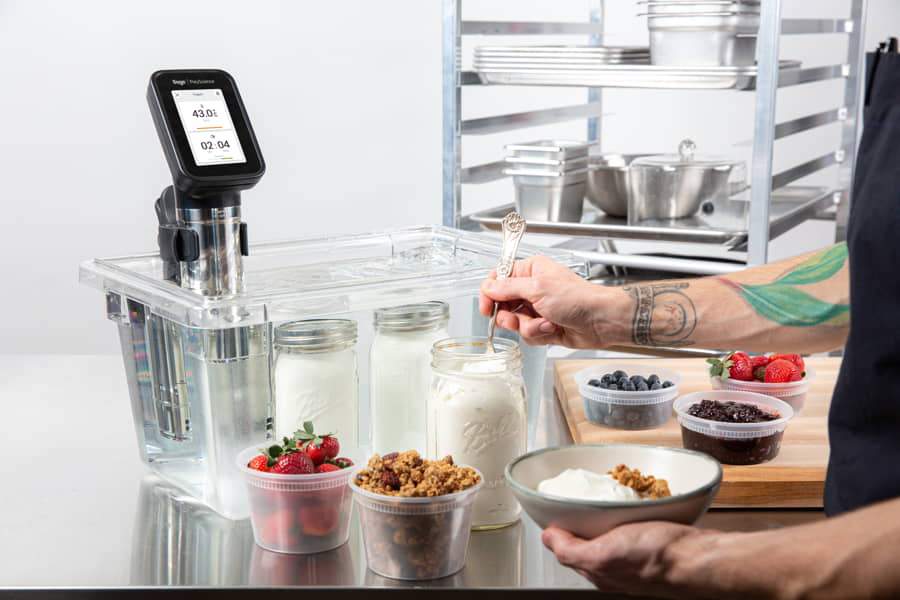
Anyone who wants to take advantage of a cooking system that allows:
Vacuum-cooked foods retain as much of their integrity and important nutrients as possible.
As they are not lost with cooking liquids and the temperature is lower than with traditional techniques, more nutrients remain in the food.
Meat and fish fats, which can be easily damaged at high temperatures in the presence of oxygen, remain unoxidized, intact and healthier.
The Professional Sous Vide can be used as a slow cooker, but it outperforms any slow cooker in the following aspects:
One of the great advantages of a Professional Sous Vide is that it will hold any size vessel, pot or pot, from a small stock pot that holds food for 2-4 people, to the maximum volume at 7.4 gallons (28 liters).
This allows you to cook for more than 50 people, or cook several foods at the same time for more than 25 people.
When filling the water bath with food, there should always be sufficient space to allow for water circulation.
Be sure to cover the bath with our custom lids or plastic wrap to improve heat efficiency and prevent evaporation.
This is especially important at higher temperatures such as 185°F/85°C when cooking vegetables.
Yes, there are two ways to cook a whole meal:
Meals with different foods are cooked at different temperatures.
Since food is not overcooked when kept at a lower temperature, one simply arranges the sequence from high to low temperature.
For example, cook the carrots and potatoes first at 185°F/85°F for 45 minutes, then lower the temperature to 138°F/59°C for a rare beef tenderloin. Adding ice cubes helps to speed up the cooling process.
Pre-cook different foods, cool them in an ice bath and store them in the refrigerator. Later, reheat all foods to the temperature you used for the food with the lowest temperature, which would be 138°F/59°C, for example, when serving rare meats.
One-pot meals and stews:
A Professional Sous Vide can be used as a slow cooker. Simply vacuum seal your stew in a bag or fill it in a container that will sit in the water bath and cook with the surrounding temperature-controlled liquid.
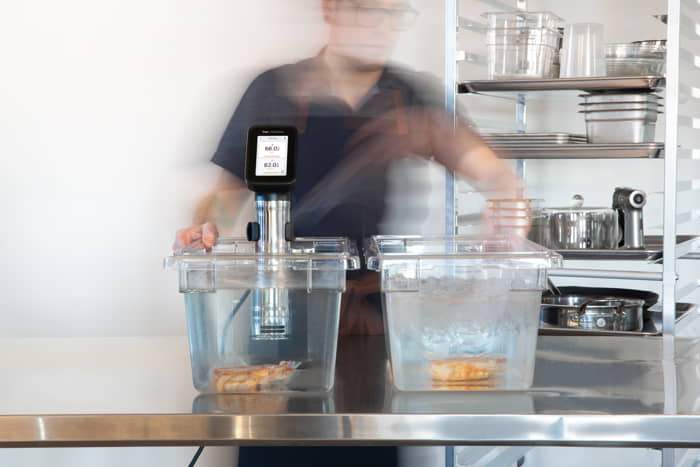
Yes, there are two ways to cook a whole meal:
Meals with different foods are cooked at different temperatures.
Since food is not overcooked when kept at a lower temperature, one simply arranges the sequence from high to low temperature.
For example, cook the carrots and potatoes first at 185°F/85°F for 45 minutes, then lower the temperature to 138°F/59°C for a rare beef tenderloin. Adding ice cubes helps to speed up the cooling process.
Pre-cook different foods, cool them in an ice bath and store them in the refrigerator. Later, reheat all foods to the temperature you used for the food with the lowest temperature, which would be 138°F/59°C, for example, when serving rare meats.
One-pot meals and stews:
A Professional Sous Vide can be used as a slow cooker. Simply vacuum seal your stew in a bag or fill it in a container that will sit in the water bath and cook with the surrounding temperature-controlled liquid.
An immersion thermostat, such as the PolyScience Professional Sous Vide.
A table-top food sealer or a vacuum chamber sealer.
Food grade vacuum plastic bags, rated for boiling temperatures.
A container that serves as a water bath, such as a pot or Camwear tank.
Any type of delicate or tougher cut of meat, such as beef, pork, lamb, game or poultry. The beef tenderloin will be perfectly cooked at all times.
The ribs will be as tender and juicy as I have ever tasted them before.
It is excellent for delicate fish and shellfish, as it ensures that these delicate foods do not dry out or overcook.
Vegetables and potatoes benefit greatly in flavor and consistency from sous vide cooking.
Green vegetables (broccoli, green beans, etc.) lose their vibrant color due to longer cooking times. Chefs usually choose to cook them in a more traditional way.
Eggs can be cooked very precisely in a Sous Vide circulation bath. Eggs do not have to be vacuum packed.
Fruits, particularly delicate ones such as peaches, apples and pears, become very tender and benefit when cooked with flavored infusions.
Cook ice cream bases such as custard, béarnaise sauce, crème anglaise and custard without worrying about curdling. The Professional Sous Vide water bath is excellent for keeping these flans and sauces at serving temperature.
Because the food is packaged in food grade bags and cooked in its own natural flavors, it does not give off aroma and moisture to the surrounding liquid or air. The seasoning will be more efficient and require less than usual.
In the case of herbs, it is recommended to use only 30% of what would normally be used.
Salt and pepper will not be applied very differently from other methods.
It is important to evenly distribute the seasoning in the bag or in the food.
Otherwise, there will be parts that have more spice than others.
For example: if cooking carrots in cumin butter, simply melt the butter and mix in the cumin powder before putting it in the bag.
One difference from traditional methods is the use of raw garlic.
Raw garlic added to foods such as steak, chicken or fish is not cooked at sous vide temperature.
The result is an excessive flavor.
To avoid this, we recommend adding the garlic after it has been sautéed or roasted.
The alcohol in wine, beer, spirits or distillates does not evaporate as it does in cooking or baking and may develop an unpleasant taste.
We recommend pre-cooking any alcohol-based liquid that is added as a flavoring when cooking Sous Vide.
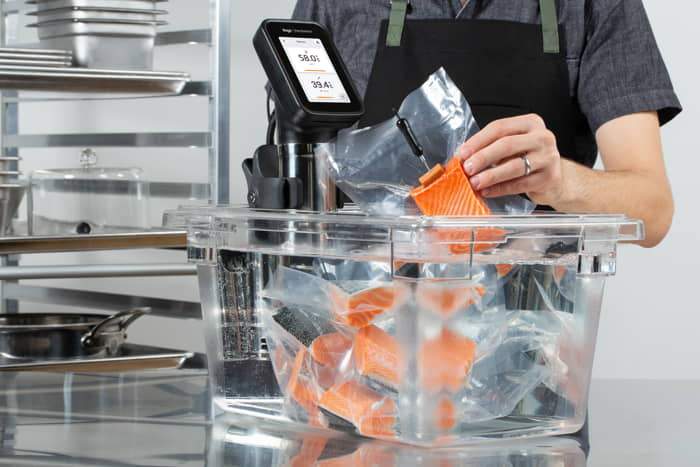
Yes, there are two ways to cook a whole meal:
Meals with different foods are cooked at different temperatures.
Since food is not overcooked when kept at a lower temperature, one simply arranges the sequence from high to low temperature.
For example, cook the carrots and potatoes first at 185°F/85°F for 45 minutes, then lower the temperature to 138°F/59°C for a rare beef tenderloin. Adding ice cubes helps to speed up the cooling process.
Pre-cook different foods, cool them in an ice bath and store them in the refrigerator. Later, reheat all foods to the temperature you used for the food with the lowest temperature, which would be 138°F/59°C, for example, when serving rare meats.
One-pot meals and stews:
A Professional Sous Vide can be used as a slow cooker. Simply vacuum seal your stew in a bag or fill it in a container that will sit in the water bath and cook with the surrounding temperature-controlled liquid.
– Simply place all ingredients in a large size (1 gallon/3.8 liters) zip-top freezer bag, remove as much air as possible from the bag and zipper it closed or use the vacuum sealer to seal only without removing air to ensure a great seal.
– Raise the vacuum sealer to a level that makes it difficult for the pump to raise the liquid. This slows down the liquid rising process and allows you to press the sealing button before it reaches the sealing zone.
Ideally, there should be nothing but the thin plastic between the food and the water.
This allows for efficient heat transfer and uniform cooking.
The fact that there is little air in the bag can be solved by putting some weight on it, such as a porcelain plate.
If the bag was properly vacuum sealed and did not float at the beginning of the cooking process and has suddenly developed air inside the bag, you should thoroughly check whether that food was not contaminated with bacteria and has therefore become a food safety risk.
If the cooking water has taken on a food color or aroma, it is an indicator that the bag is not properly sealed and should be discarded.
Depending on the vacuum level, the food can be compressed and change texture from compact packaging.
When liquids are added, the vacuum sealing process creates rapid infusion, especially with more porous foods.
This can provide benefits to flavor and texture, but is not always the desired result.
For example, a delicate fish fillet or a chicken breast can acquire a very dense texture.
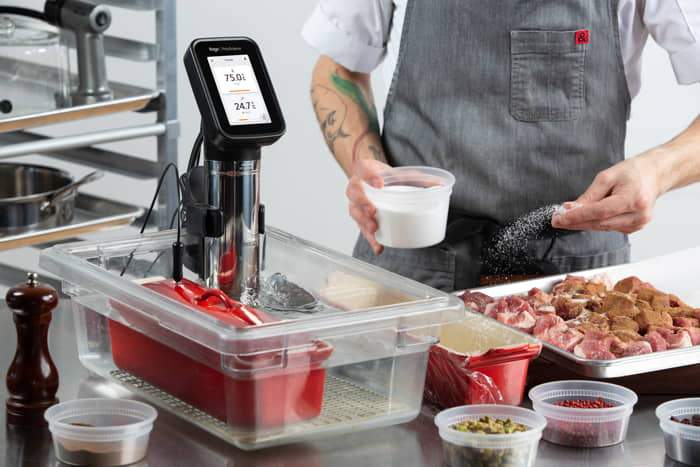
PolyScience provides a Sous Vide cookbook with the Sous Vide Professional that lists several recipes and a table with time/temperature guidelines for the most commonly Sous Vide cooked foods.
With the Sous Vide technique, there is a much greater margin of time to achieve the perfect cooking point.
Time is much less critical as the food is not overexposed to heat and therefore cannot be overcooked in the traditional sense.
Cooking time depends on the thickness and tenderness of the food.
It can range from 20 to 30 minutes (lean fish, foie gras, scrambled eggs) to 72 hours (ribs, hard meats).
Thickness: The time it takes for a portion of food to reach temperature depends on the thickness of the portion, not the total weight.
Cooking time increases exponentially with thickness.
A 4-inch thick fillet needs at least 3 times more cooking time than a 2-inch thick fillet.
Tenderness: Tender or delicate foods (fish, seafood, foie gras, beef or pork tenderloin, lamb chops) need only be brought to the desired serving temperature to be delicious and ready to eat.
Prolonged cooking times may cause them to become too tender to the point of becoming mushy.
Portion chicken breasts and tender fillets usually require a minimum of one to two hours, depending on thickness.
Harder foods (roasts, grass-fed cuts, game, ribs) will be brought to temperature depending on the thickness of the portion, but will then benefit from slow cooking for hours to tenderize them.
Flank steaks and beef roasts usually require a minimum of six hours and a maximum of twelve hours.
The ribs and steaks are cooked for twenty-four to forty-eight hours.
They cannot be cooked at the same time, but there are simple tricks to prepare different cooking levels.
Method 1: Cook all steaks in a bain-marie until done, and then, when finishing the steaks in the pan or on the grill, simply let the steak sear a little longer.
Method 2: Cook the two steaks sequentially – the medium steak at 140°F/60°C a day or an hour ahead, then lower the temperature to 138°F/59°C and add the medium rare steak for another hour.
Both are cooked to perfection.
The medium steak will not be overcooked, as it is only held until ready to serve.
Once the rare steak is cooked to perfection, brown it quickly for flavor and appearance in a hot skillet or on a grill.
Yes. It can be done if you do not have PolyScience recipes on hand or want to develop your own recipes.
The best way is to open the bag at the top, measure the temperature and reseal the bag if necessary.
Other ways are to apply foam tape to the bag, prick a temperature needle through the bag and measure that way.
However, this method cannot be considered food safe, as the seal is broken and water is likely to leak into the bag.
We recommend this method only for recipe development, but not for food served for consumption.
With the Sous Vide method, food is cooked precisely and gently to the desired serving temperature.
Sous Vide cooking temperatures are usually in the range of 115-190 degrees F, and always below boiling.
The key to successful sous vide cooking is to maintain a constant water temperature throughout the cooking period.
A difference of as little as one degree can change the appearance, taste and texture of some foods.
This level of control allows you to repeat over and over again the same exact results of your steak, chicken, scallops or eggs.
Quick reference for cooking temperatures of the most common foods:
Yes, all slow cooker recipes will work and turn out even more delicious and cook perfectly according to the set temperature.
For well-done foods, simply cook all the ingredients together at 185°F/ 85°C.
For rare to medium foods, lightly sauté or steam vegetables in the skillet, then add them to the meat and spices and cook in the container or food bag.
To cook the recipe in a Sous Vide, you can:
Use zipper bags for food: Remove air and close the zipper.
Vacuum sealing food.
Fill the food into a stainless steel or ceramic cooking vessel that fits into the water bath, controlled by the Sous Vide.
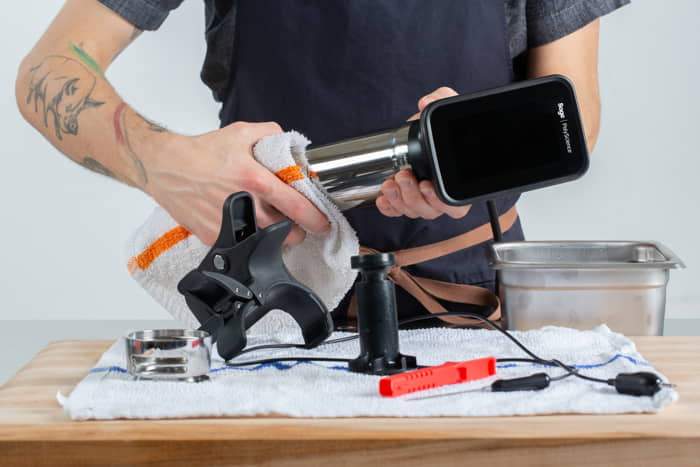
The main concern about cooking in plastic bags has to do with the leaching of potentially harmful chemicals, such as BPA (bisphenol-A) and phthalates, or toxic metals, such as lead, from the bag into the food.
Food grade plastic bags, certified as safe for cooking by their manufacturer, are safe.
Reducing the risk of foodborne illness when cooking food depends not only on temperature, but also on time.
The lower the temperature, the longer the time.
For example, Salmonella, a common type of foodborne bacteria, will die in 30 seconds at 150°F/65.5°C, but will take 15 minutes to do so at 130°F/54.5°C.
Almost all potentially harmful organisms will be killed at 130°F/54.5°C if sufficient time is given to fully heat the food to that temperature.
Since most sous vide cooking is done between 130°F/54.5°C and 195°F/95°C, the food will be safe.
The most common exception is fish, which some people prefer to eat rare or medium rare (116°F/46.5°C to 126°F/52°C).
In this case, it is important to buy only fish that you are willing to eat raw, i.e. sushi quality ocean fish.
Important warning: People who are immunosuppressed for any reason should not eat raw food; they should only eat food cooked at or above 140°F/60°C for sufficient time to ensure pasteurization of the food.
Vacuum packaging creates an anaerobic or low-oxygen environment that can support the growth of bacteria such as salmonella and botulism when food is improperly handled.
Food hygiene and handling standards must always be maintained.
When handling food, whether cooking sous vide or using more traditional techniques, all cooks should be familiar with basic food safety practices:
Work only with fresh food that is well cleaned.
Avoid cross-contamination by using separate cutting boards, washing hands and using separate, clean storage units.
Respect the recommended temperature and cooking times to avoid bacterial growth.
Serve the food immediately or cool it adequately in an ice bath and store it immediately in the refrigerator.
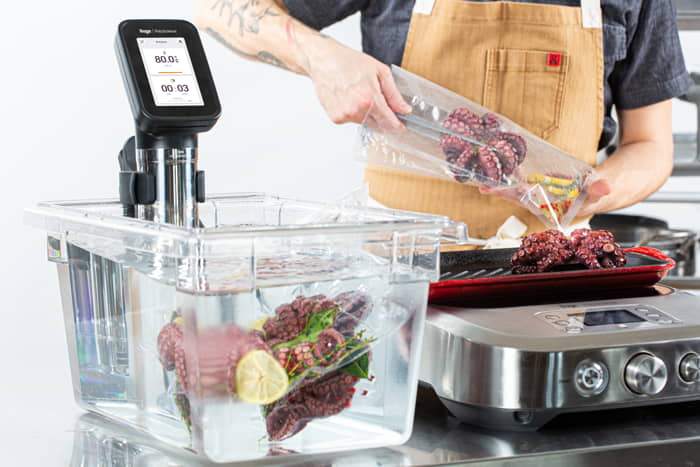
Any fresh food cooked properly and cooled quickly can be safely stored in its bag in the refrigerator for up to 48 hours.
After 48 hours, depending on the type of food.
Delicate proteins, such as fish and seafood, should be consumed or frozen after this period.
Vegetables and meats that have been cooked for more than 6 hours at 140°F/60°C can be stored for 1 week before they need to be consumed.
Completely submerge the food in its bag in an ice bath (50/50 ice cubes and water) to allow the temperature to drop rapidly through the danger zone (40°F/4°C to 130°F/54°C).
The time the food should remain immersed in ice water should reflect the minimum cooking time for that food, in most cases 30 minutes to 1 hour.
Do not place hot or warm bags in the refrigerator.
They will not cool quickly enough and will heat up your refrigerator and the other food in it.
Yes. This is very practical in two situations:
When cooking with frozen raw ingredients, the cooking time should be extended by the time it needs to thaw.
This is usually double or more the normal cooking time.
When reheating previously cooked sous vide and frozen foods, the time in the sous vide water bath depends only on how quickly the serving temperature is reached.
Whole chicken, duck or game hen in one piece.
The problem with this for either method is that white and dark meats require different cooking times.
In the case of Sous Vide specifically, a whole bird cannot be vacuum-sealed without a cavity remaining, resulting in uneven cooking.
It is recommended to divide the parts and cook the legs and thighs separately from the breasts.
Green vegetables, such as green asparagus, broccoli and spinach. According to our experience and the opinion of the best chefs in the world, green vegetables do not benefit from longer cooking times and low temperatures.
Traditional methods such as blanching or sautéing achieve much better results.
Hamburgers or any minced meat or fish. From a food safety point of view, we do not recommend cooking hamburgers under vacuum.
Bacteria grow on the surface of ground meats due to their larger surface area with a much higher risk of bacterial contamination than portioned cuts of meat – unless cooked at higher temperatures and for a prolonged time.
In this case, it is better to use a traditional grill.
With Professional Sous Vide, food can be kept at the desired cooking temperature for much longer than with traditional cooking techniques.
However, at some point the food will become mushy and overcooked in texture.
To ensure perfect results, we recommend the following rules of thumb:
For best results, do not hold food at cooking temperature for twice its minimum cooking time.
The maximum cooking time is 72 hours.

TÖUFOOD is a complete line of products of exceptional quality, developed by GASTROCULTURA MEDITERRÁNEA SL, which allows the most well-known techniques of modern cuisine to be put into practice. Innovative recipes can be easily realised, bringing excitement and surprise to dishes, offering a stimulating and memorable culinary experience.